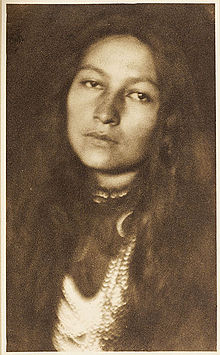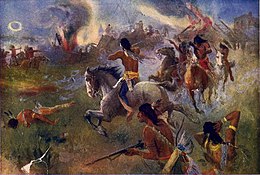This is an old revision of this page, as edited by Isinbill (talk | contribs) at 22:13, 13 October 2015. The present address (URL) is a permanent link to this revision, which may differ significantly from the current revision.
Revision as of 22:13, 13 October 2015 by Isinbill (talk | contribs)(diff) ← Previous revision | Latest revision (diff) | Newer revision → (diff) Ethnic group Dr. Charles Alex Eastman (1858–1939), physician, author, and co-founder of the Boy Scouts of America Dr. Charles Alex Eastman (1858–1939), physician, author, and co-founder of the Boy Scouts of America | |
| Regions with significant populations | |
|---|---|
| Languages | |
| Dakota, English | |
| Religion | |
| Christianity (incl. syncretistic forms), traditional tribal religion, Native American Church | |
| Related ethnic groups | |
| Lakota, Assiniboine, Stoney (Nakoda), and other Sioux |
The Dakota people are a Native American tribe and First Nations band government in North America. They compose two of the three main subcultures of the Sioux /ˈsuː/ people, and are usually divided into the Eastern Dakota and the Western Dakota.
The Eastern Dakota are the Santee (Isáŋyathi or Isáŋathi; "Knife"), who reside in the extreme east of the Dakotas, Minnesota and northern Iowa. The Western Dakota are the Yankton and the Yanktonai (Iháŋktȟuŋwaŋ and Iháŋktȟuŋwaŋna; "Village-at-the-end" and "Little village-at-the-end"), who reside in the Missouri River area. The Yankton-Yanktonai are collectively also referred to by the endonym Wičhíyena, and have in the past been erroneously classified as Nakota.
Name
The word Dakota means "ally" in the Dakota language, and their autonyms include Ikčé Wičhášta ("Indian people") and Dakhóta Oyáte ("Dakota people").
Ethnic groups

The Dakota compose two of the three major ethnic groups of Sioux people; the third being the Lakota (Thítȟuŋwaŋ or Teton). The Dakota include the following bands: Bdewákaŋthuŋwaŋ (Mdewakanton), Waȟpéthuŋwaŋ (Wahpeton), Waȟpékhute (Wahpekute), Sisíthuŋwaŋ (Sisseton), the Iháŋkthuŋwaŋ (Yankton), and Iháŋkthuŋwaŋna (Yanktonai).
- The Santee live on reservations, reserves, and communities in Minnesota, Nebraska, South Dakota, North Dakota, and Canada. However, after the Dakota war of 1862 many Santee were sent to Crow Creek Indian Reservation and in 1864 some from the Crow Creek Reservation were sent to the Santee Sioux Reservation.
- Most of the Yanktons live on the Yankton Indian Reservation in southeastern South Dakota. Some Yankton live on the Lower Brule Indian Reservation and Crow Creek Reservation. The Yanktonai are divided into Lower Yanktonai, who occupy the Crow Creek Reservation; and Upper Yanktonai, who live in the northern part of Standing Rock Reservation, on the Spirit Lake Reservation in central North Dakota, and in the eastern half of the Fort Peck Indian Reservation in northeastern Montana. In addition, they reside at several Canadian reserves, including Birdtail, Oak Lake, and Moose Woods.

- Santee division (Eastern Dakota) (Isáŋyathi, meaning "knife")
- Mdewakantonwan (Bdewékhaŋthuŋwaŋ "Spirit Lake Village" or "people of the mystic lake")
- notable persons: Taoyateduta
- Sisseton (Sisíthuŋwaŋ, translating to "swamp/lake/fish scale village")
- Wahpekute (Waȟpékhute, "Leaf Archers")
- notable persons: Inkpaduta
- Wahpetonwan (Waȟpéthuŋwaŋ, "Leaf Village")
- Mdewakantonwan (Bdewékhaŋthuŋwaŋ "Spirit Lake Village" or "people of the mystic lake")
- Yankton-Yanktonai division (Western Dakota) (Wičhíyena)
- Yankton (Iháŋkthuŋwaŋ, "End Village")
- Yanktonai (Iháŋkthuŋwaŋna, "Little End Village")
- Upper Yanktonai
- Unkpatina or Lower Yanktonai
History
First contacts with Europeans
The Dakota lived in Wisconsin and Minnesota in the 17th century. By 1700 some had migrated to present-day South Dakota. Late in the 17th century, the Dakota entered into an alliance with French merchants. The French were trying to gain advantage in the struggle for the North American fur trade against the English, who had recently established the Hudson's Bay Company.
Dakota War of 1862
Main article: Dakota War of 1862

By 1862, shortly after a failed crop the year before and a winter starvation, the federal payment was late. The local traders would not issue any more credit to the Santee and one trader, Andrew Myrick, went so far as to say, "If they're hungry, let them eat grass." On August 17, 1862 the Dakota War began when a few Santee men murdered a white farmer and most of his family. They inspired further attacks on white settlements along the Minnesota River. The Santee attacked the trading post. Later settlers found Myrick among the dead with his mouth stuffed full of grass.
On November 5, 1862 in Minnesota, in courts-martial, 303 Santee Dakota were found guilty of rape and murder of hundreds of American settlers. They were sentenced to be hanged. No attorneys or witness were allowed as a defense for the accused, and many were convicted in less than five minutes of court time with the judge. President Abraham Lincoln commuted the death sentence of 284 of the warriors, while signing off on the execution of 38 Santee men by hanging on December 26, 1862 in Mankato, Minnesota. Forty-three-year-old Alexander Wilkin commanded the executions, which together amounted to the largest single mass execution in U.S. history.
Afterwards, the US suspended treaty annuities to the Dakota for four years and awarded the money to the white victims and their families. The men remanded by order of President Lincoln were sent to a prison in Iowa, where more than half died.
During and after the revolt, many Santee and their kin fled Minnesota and Eastern Dakota to Canada, or settled in the James River Valley in a short-lived reservation before being forced to move to Crow Creek Reservation on the east bank of the Missouri. A few joined the Yanktonai and moved further west to join with the Lakota bands to continue their struggle against the United States military.
Others were able to remain in Minnesota and the east, in small reservations existing into the 21st century, including Sisseton-Wahpeton, Flandreau, and Devils Lake (Spirit Lake or Fort Totten) Reservations in the Dakotas. Some ended up in Nebraska, where the Santee Sioux Tribe today has a reservation on the south bank of the Missouri.
Those who fled to Canada now have descendants residing on nine small Dakota Reserves, five of which are located in Manitoba (Sioux Valley, Long Plain, Dakota Tipi, Birdtail Creek, and Oak Lake ) and the remaining four (Standing Buffalo, Moose Woods , Round Plain , and Wood Mountain) in Saskatchewan.
Reserves and First Nations
In Minnesota, the treaties of Traverse des Sioux and Mendota in 1851 left the Dakota with a reservation 20 miles (32 km) wide on each side of the Minnesota River.
In Canada, the Canadian government recognizes the tribal community as First Nations. The land holdings of the these First Nations are called Indian Reserves.
Modern reservations, reserves, and communities of the Sioux
(* Reserves shared with other First Nations)
Language
Main article: Dakota languageThe Dakota languages is a Mississippi Valley Siouan language, belonging to the greater Siouan-Catawban language family. It shared lexical similarities with the Stoney and Assiniboine languages. Dakota is written in the Latin script and has a dictionary and grammar.
- Eastern Dakota (also known as Santee-Sisseton or Dakhóta)
- Santee (Isáŋyáthi: Bdewákhathuŋwaŋ, Waȟpékhute)
- Sisseton (Sisíthuŋwaŋ, Waȟpéthuŋwaŋ)
- Western Dakota (or Yankton-Yanktonai or Dakȟóta)
- Yankton (Iháŋktȟuŋwaŋ)
- Yanktonai (Iháŋktȟuŋwaŋna)
Modern geographic divisions
The Dakota maintain many separate tribal governments scattered across several reservations and communities in North America: in the Dakotas, Minnesota, Nebraska, and Montana in the United States; and in Manitoba, southern Saskatchewan in Canada.
The earliest known European record of the Dakota identified them in Minnesota, Iowa, and Wisconsin. After the introduction of the horse in the early 18th century, the Sioux dominated larger areas of land—from present day Central Canada to the Platte River, from Minnesota to the Yellowstone River, including the Powder River country.
Santee (Isáŋyathi or Eastern Dakota)
The Santee migrated north and westward from the Southeast United States, first into Ohio, then to Minnesota. Some came up from the Santee River and Lake Marion, area of South Carolina. The Santee River was named after them, and some of their ancestors' ancient earthwork mounds have survived along the portion of the dammed-up river that forms Lake Marion. In the past, they were a Woodland people who thrived on hunting, fishing and farming.
Migrations of Ojibwe people from the east in the 17th and 18th centuries, with muskets supplied by the French and British, pushed the Dakota further into Minnesota and west and southward. The US gave the name "Dakota Territory" to the northern expanse west of the Mississippi River and up to its headwaters.
Iháŋkthuŋwaŋ-Iháŋkthuŋwaŋna (Yankton-Yanktonai or Western Dakota)
The Iháŋkthuŋwaŋ-Iháŋkthuŋwaŋna, also known by the anglicized spelling Yankton (Iháŋkthuŋwaŋ: "End village") and Yanktonai (Iháŋkthuŋwaŋna: "Little end village") divisions consist of two bands or two of the seven council fires. According to Nasunatanka and Matononpa in 1880, the Yanktonai are divided into two sub-groups known as the Upper Yanktonai and the Lower Yanktonai (Hunkpatina).
They were involved in quarrying pipestone. The Yankton-Yanktonai moved into northern Minnesota. In the 18th century, they were recorded as living in the Mankato region of Minnesota.
Notable Dakota people
Historical
- Inkpaduta (Scarlet Point/Red End), Wahpekute Dakota war chief
- Ištáȟba (Sleepy Eye), Sisseton Dakota chief
- Ohíyes’a (Charles Eastman), Dakota author, physician and reformer
- Tamaha (One Eye/Standing Moose), Mdewekanton Dakota chief
- Thaóyate Dúta (Little Crow/His Red Nation), Mdewakanton Dakota chief and warrior
- Wanata, War Eagle, Unkpatina
- Waŋbdí Tháŋka (Big Eagle), Mdewakanton Dakota chief
- Zitkala-Ša (Gertrude Simmons Bonnin, 1876–1938), Yankton author, educator, musician and political activist
Contemporary

Contemporary Sioux people are listed under the tribes to which they belong.
By individual tribe
- Assiniboine and Sioux Tribes of the Fort Peck Indian Reservation
- Crow Creek Sioux Tribe of the Crow Creek Reservation
- Flandreau Santee Sioux Tribe
- Lower Brule Sioux Tribe of the Lower Brule Reservation
- Shakopee Mdewakanton Sioux Community
- Sisseton Wahpeton Oyate
- Standing Rock Sioux Tribe of North & South Dakota
- Yankton Sioux Tribe of South Dakota
Footnotes
- ^ "Dakota." Ethnologue. Retrieved 8 January 2013.
- for a report on the long-established blunder of misnaming as “Nakota”, the Yankton and the Yanktonai, see the article Nakota
- ^ Barry M. Pritzker, A Native American Encyclopedia: History, Culture, and Peoples. Oxford: Oxford University Press, 2000; pg. 316
- ^ Ullrich, Jan (2008). New Lakota Dictionary (Incorporating the Dakota Dialects of Yankton-Yanktonai and Santee-Sisseton). Lakota Language Consortium. pp. 1–2. ISBN 0-9761082-9-1.
- not to be confused with the Oglala thiyóšpaye bearing the same name, "Unkpatila"
- Hyde, George E. (1984). Red Cloud's Folk: A History of the Oglala Sioux Indians. Norman: University of Oklahoma Press. p. 3. ISBN 0-8061-1520-3.
- Johnson, Michael; Smith, Jonathan (2000). Tribes of the Sioux Nation. Oxford: Osprey Publishing. p. 3. ISBN 1-85532-878-X.
- van Houten, Gerry (1991). Corporate Canada An Historical Outline. Toronto: Progress Books. pp. 6–8. ISBN 0-919396-54-2.
- Dillon, Richard (1993). North American Indian Wars. City: Booksales. p. 126. ISBN 1-55521-951-9.
- Steil, Mark; Tim Post (2002-09-26). "Let them eat grass". Minnesota Public Radio. Retrieved 2011-09-21.
- ^ War for the Plains. Time-Life Books. 1994. ISBN 0-8094-9445-0.
- Steil, Mark; Tim Post (2002-09-26). "Execution and expulsion". Minnesota Public Radio. Retrieved 2011-10-02.
- Johnson, Michael (2000). The Tribes of the Sioux Nation. Osprey Publishing Oxford. ISBN 1-85532-878-X.
- Mails, Thomas E. (1973). Dog Soldiers, Bear Men, and Buffalo Women: A Study of the Societies and Cults of the Plains Indians. Prentice-Hall, Inc. ISBN 0-13-217216-X.
- ^ Riggs, Stephen R. (1893). Dakota Grammar, Texts, and Ethnography. Washington Government Printing Office, Ross & Haines, Inc. ISBN 0-87018-052-5.
- OneRoad, Amos E.; Alanson Skinner (2003). Being Dakota: Tales and Traditions of the Sisseton and Wahpeton. Minnesota Historical Society. ISBN 0-87351-453-X.
Further reading
- Catherine J. Denial, Making Marriage: Husbands, Wives, and the American State in Dakota and Ojibwe Country. St. Paul, MN: Minnesota Historical Society Press, 2013.